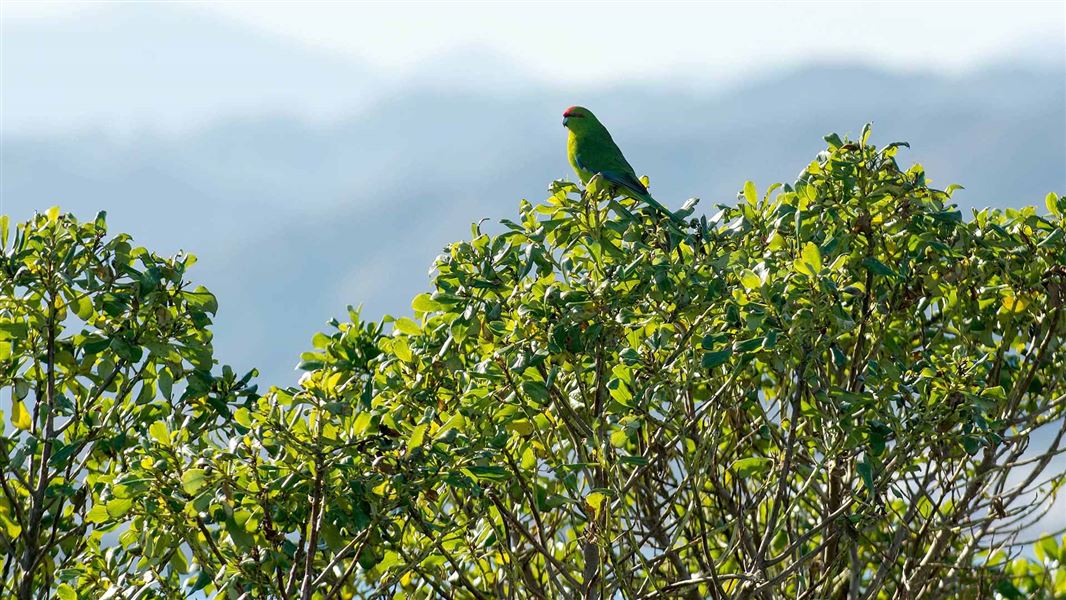Rat-free island
Ship rats and other pests were eradicated from the island in the late 1980s.
Since that time, the island has become a sanctuary for native plants, birds, reptiles and invertebrates. For this reason, it is important that all visitors check bags at the Whare Kiore upon their arrival, to help keep Matiu/Somes free of pests.
Birds on the island
"Kita, kita, kita, kita"
With its successful reintroduction, the sounds of the red-crowned parakeet/kākāriki can again be heard on the island. This brightly-coloured, green and red bird used to be quite common across mainland New Zealand.
North Island robin have also been relocated to the island from nearby Kapiti Island and Karori Wildlife Sanctuary.
Other native forest bird populations include fantail, kingfisher and silvereye. Introduced species, such as the chaffinch and dunnock, also occur on Matiu/Somes.
The island is inhabited by a variety of seabirds, such as southern black-backed gull, spotted shag, and variable oystercatcher. There are plans to reintroduce several other native bird species to Matiu/Somes. Ask the ranger about current activities.
Refuge for the world’s smallest penguin
Matiu/Somes provides critical habitat for the world’s smallest penguin - little penguin/kororā.
Without the threat of cars and predators, namely ferrets, stoats, weasels and dogs, on the island, the penguins nest and raise their young in relative safety.
The protection that the island affords little penguins during nesting season is also vital when they moult each summer. Moulting lasts about two weeks, during which time the penguins do not eat or swim.
Little penguins are also known as little blue penguins.
Amazing weta
There are 500 species of invertebrates on Matiu/Somes and Mokopuna islands, including several species of weta. The Cook Strait giant weta and Wellington tree weta were reintroduced to the island in the late 1990s.
Skinks, geckos and tuatara
Eight species of reptiles found only in New Zealand, occur on Matiu/Somes - common skink, spotted skink, copper skink, ornate skink, common gecko, forest gecko, Wellington green gecko and Brothers Island tuatara. Visitors often hear and see skinks along the island’s tracks. The nocturnal geckos and tuatara are less frequently seen, but sightings do occur, so keep your eyes peeled.
Tuatara belong to an ancient order of reptiles, and have no other living relatives. Matiu / Somes Island’s original tuatara population was wiped out by the mid-1800s. However, in 1998, more than 50 Brothers Island tuatara were successfully introduced. Suspicions that they were breeding on the island were finally confirmed in 2007, with the hatching of two tuatara in August from eggs found on the island three months earlier. The eggs were incubated at Victoria University of Wellington School of Biological Sciences and the baby tuatara were released onto the island at a ceremony in November 2007. They were named after the Wellington Harbour taniwha Ngake and Whataitai. The names were decided in a competition open to the public.
Volunteers replanting
The revegetation effort, initiated by the Lower Hutt branch of Forest and Bird and the Ministry of Agriculture and Fisheries in 1981, has fostered the regeneration of native plant and wildlife species on the island.
Thousands of volunteers have toiled since 1981 to return the island’s landscape from livestock paddocks to native vegetation that existed on the island prior to the arrival of European settlers.
Initially, pioneering species, such as taupata, ngaio and harakeke were planted on the island. As they became established, secondary species, including totara, rata and kahikatea, were added to the planting scheme. Long-term plans include reintroductions of threatened local native plant species.
